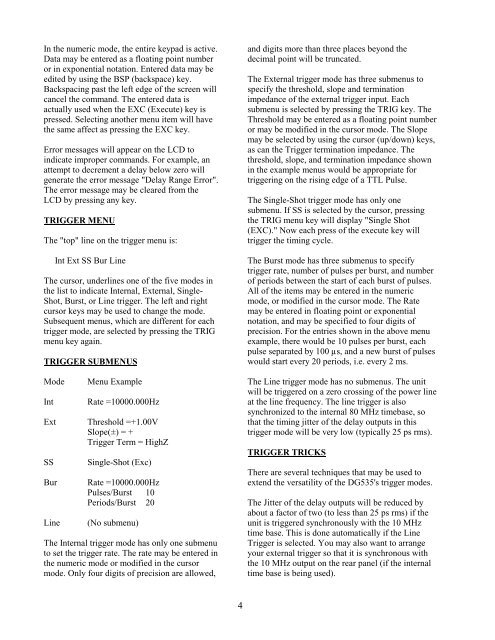MODEL DG535 Digital Delay / Pulse Generator - SLAC
MODEL DG535 Digital Delay / Pulse Generator - SLAC
MODEL DG535 Digital Delay / Pulse Generator - SLAC
- No tags were found...
Create successful ePaper yourself
Turn your PDF publications into a flip-book with our unique Google optimized e-Paper software.
In the numeric mode, the entire keypad is active.Data may be entered as a floating point numberor in exponential notation. Entered data may beedited by using the BSP (backspace) key.Backspacing past the left edge of the screen willcancel the command. The entered data isactually used when the EXC (Execute) key ispressed. Selecting another menu item will havethe same affect as pressing the EXC key.Error messages will appear on the LCD toindicate improper commands. For example, anattempt to decrement a delay below zero willgenerate the error message "<strong>Delay</strong> Range Error".The error message may be cleared from theLCD by pressing any key.TRIGGER MENUThe "top" line on the trigger menu is:Int Ext SS Bur LineThe cursor, underlines one of the five modes inthe list to indicate Internal, External, Single-Shot, Burst, or Line trigger. The left and rightcursor keys may be used to change the mode.Subsequent menus, which are different for eachtrigger mode, are selected by pressing the TRIGmenu key again.TRIGGER SUBMENUSMode Menu ExampleIntExtSSBurLineRate =10000.000HzThreshold =+1.00VSlope(±) = +Trigger Term = HighZSingle-Shot (Exc)Rate =10000.000Hz<strong>Pulse</strong>s/Burst 10Periods/Burst 20(No submenu)The Internal trigger mode has only one submenuto set the trigger rate. The rate may be entered inthe numeric mode or modified in the cursormode. Only four digits of precision are allowed,and digits more than three places beyond thedecimal point will be truncated.The External trigger mode has three submenus tospecify the threshold, slope and terminationimpedance of the external trigger input. Eachsubmenu is selected by pressing the TRIG key. TheThreshold may be entered as a floating point numberor may be modified in the cursor mode. The Slopemay be selected by using the cursor (up/down) keys,as can the Trigger termination impedance. Thethreshold, slope, and termination impedance shownin the example menus would be appropriate fortriggering on the rising edge of a TTL <strong>Pulse</strong>.The Single-Shot trigger mode has only onesubmenu. If SS is selected by the cursor, pressingthe TRIG menu key will display "Single Shot(EXC)." Now each press of the execute key willtrigger the timing cycle.The Burst mode has three submenus to specifytrigger rate, number of pulses per burst, and numberof periods between the start of each burst of pulses.All of the items may be entered in the numericmode, or modified in the cursor mode. The Ratemay be entered in floating point or exponentialnotation, and may be specified to four digits ofprecision. For the entries shown in the above menuexample, there would be 10 pulses per burst, eachpulse separated by 100 µs, and a new burst of pulseswould start every 20 periods, i.e. every 2 ms.The Line trigger mode has no submenus. The unitwill be triggered on a zero crossing of the power lineat the line frequency. The line trigger is alsosynchronized to the internal 80 MHz timebase, sothat the timing jitter of the delay outputs in thistrigger mode will be very low (typically 25 ps rms).TRIGGER TRICKSThere are several techniques that may be used toextend the versatility of the <strong>DG535</strong>'s trigger modes.The Jitter of the delay outputs will be reduced byabout a factor of two (to less than 25 ps rms) if theunit is triggered synchronously with the 10 MHztime base. This is done automatically if the LineTrigger is selected. You may also want to arrangeyour external trigger so that it is synchronous withthe 10 MHz output on the rear panel (if the internaltime base is being used).4

















